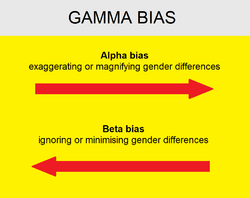Difference between revisions of "Gamma bias"
| Line 9: | Line 9: | ||
==Theories on the purpose of gamma bias== |
==Theories on the purpose of gamma bias== |
||
| − | Hypotheses regarding the |
+ | Hypotheses regarding the growth of gamma bias and the disfavoring males include the operation of evolutionary pressure for males to protect and provide for women which includes a reluctance to view men as vulnerable, or alternatively the social explanation of 'ingroup' and 'outgroup' bias which may have developed around men and women in the form of social conventions. A further explanation is provided by gynocentrism theory <ref>[https://newmalestudies.com/OJS/index.php/nms/article/view/311/374 Wright, Peter. "Gynocentrism As A Narcissistic Pathology." New Male Studies 9, no. 1 (2020).]</ref> which posits the rise of female narcissism and 'pedestalization' in intimate heterosexual relationships, a situational narcissism involves the cognitive operation of the Gamma Bias formula of maximizing/minimizing certain gendered behaviors to ensure women are always the primary beneficiaries (at men's expense). |
| − | |||
| − | I further explanation is provided by gynocentrism theory <ref>[https://newmalestudies.com/OJS/index.php/nms/article/view/311/374 Wright, Peter. "Gynocentrism As A Narcissistic Pathology." New Male Studies 9, no. 1 (2020).]</ref> which posits the rise of gendered narcissism in intimate relationships |
||
| − | |||
| − | a |
||
| − | I've come to view gynocentrism as a form of gendered narcissism, and that particular form of narcissism involves the cognitive operation of the Gamma Bias formula of maximizing/minimizing certain gendered behaviors to ensure women are always the primary beneficiaries (at men's expense). |
||
Ie. Exactly as we would see the same maximizing/minimizing process in relation to a narcissist vs. non-narcissist. |
Ie. Exactly as we would see the same maximizing/minimizing process in relation to a narcissist vs. non-narcissist. |
||
Revision as of 12:03, 10 September 2022
Gamma bias refers to a cognitive gender bias theory developed by Seager & Barry (2019).[1]
Gamma bias entails the interrelation of two concurrent biases: alpha bias (exaggerating or magnifying gender differences) and beta bias (ignoring or minimizing gender differences). Gamma bias occurs when one gender difference is minimized while simultaneously another is magnified, resulting in a doubling of the cognitive distortion.[2]
The authors state that gamma bias works to magnify women's issues and achievements and to minimize men's issues and achievements. Alternatively, the dynamic is reversed and employed to minimize negative female traits and behaviors, while magnifying or exaggerating negative male traits or behaviors.
Theories on the purpose of gamma bias
Hypotheses regarding the growth of gamma bias and the disfavoring males include the operation of evolutionary pressure for males to protect and provide for women which includes a reluctance to view men as vulnerable, or alternatively the social explanation of 'ingroup' and 'outgroup' bias which may have developed around men and women in the form of social conventions. A further explanation is provided by gynocentrism theory [3] which posits the rise of female narcissism and 'pedestalization' in intimate heterosexual relationships, a situational narcissism involves the cognitive operation of the Gamma Bias formula of maximizing/minimizing certain gendered behaviors to ensure women are always the primary beneficiaries (at men's expense).
Ie. Exactly as we would see the same maximizing/minimizing process in relation to a narcissist vs. non-narcissist.
the gamma bias theory as a hypothesis for misandry and gynocentrism.
Further reading
References
- ↑ Seager, M., Barry, J.A. (2019). Cognitive Distortion in Thinking About Gender Issues: Gamma Bias and the Gender Distortion Matrix. In: Barry, J., Kingerlee, R., Seager, M., Sullivan, L. (eds) The Palgrave Handbook of Male Psychology and Mental Health. Palgrave Macmillan
- ↑ John Barry & Martin Seager, Can we discuss gender issues rationally? Yes, if we can stop gamma bias
- ↑ Wright, Peter. "Gynocentrism As A Narcissistic Pathology." New Male Studies 9, no. 1 (2020).
